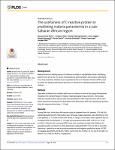The usefulness of C-reactive protein in predicting malaria parasitemia in a sub-Saharan African region
Sarfo, Bismark Osei
Hahn, Andreas
Schwarz, Norbert Georg
Jaeger, Anna
Sarpong, Nimako
Marks, Florian
Adu-Sarkodie, Yaw
Tamminga, Thalea
May, Juergen
Background:
Malaria remains a leading cause of childhood mortality in sub-Saharan Africa. Identifying patients who are at risk for severe manifestations at presentation still remains challenging. This study examines whether a semi-quantitative test on C-Reactive Protein (CRP) could be useful for rapidly predicting the presence or absence of malarial parasitemia in febrile children.
Method:
Data were collected from children with fever or a history of fever at the Agogo Presbyterian Hospital in the Ashanti Region of Ghana. Haematological measurements, microscopic detection of plasmodium species and semi-quantitative CRP measurements with a membrane–based immunoassay for whole blood were performed. CRP was classified as positive when the measured level was ≥ 10 mg/l.
Results:
During 548 visits, thick blood film results could be obtained from 541 patients, 270 (49.3%) yielded parasitemia with Plasmodium spp. Whereas malaria parasites were detected in only a few patients (7.1%) with normal CRP levels (< 10mg/l), more than a half of patients with an increased CRP concentration (≥ 10 mg/l) were parasite positive (OR 14.5 [CI 4.4–47.6], p<0.001). Patients with increased CRP levels had more than an eight-fold likelihood for parasitemia after correction for other parameters (adjusted OR 8.7 [CI 2.5–30.5], p<0.001). Sensitivity, specificity as well as positive predictive and negative predictive values of CRP for malaria were 99.3% (CI 96.2%-100%), 9.2% (CI 6.4%-12.8%), 31.7% (CI 27.4%-36.1%) and 97.0% (CI 84.2%-99.9%), respectively.
Conclusion:
The semi-quantitative method of measuring CRP is cheap, rapid and easy to perform but not useful in predicting parasitemia and malaria. However, due to its high negative predictive value, it could have a role in identifying those patients unlikely to be presenting with clinical malaria.
Dateien zu dieser Publikation

